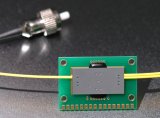Liquid crystals enable light guiding
Glass fiber optic cables ensure transmission of very high data rates over very long distances. In telecommunication networks, this technology currently has no peer. In order to exploit the potential of the optical fiber, optical switches and modulators are employed to bundle, steer and modulate the various optical signals. The Fraunhofer Institute for Photonic Microsystems IPMS Dresden, Germany, develops optical switches and modulators based on electro-optical waveguides induced in special liquid crystals. These materials are especially sensitive to electrical fields, exhibit short response times on the submicron scale and feature excellent transparency over a broad spectral range, from visible to infrared. The potential for the technology goes well beyond optical telecommunication networks. Fraunhofer IPMS will introduce this innovative technology to the public in Anaheim, California during the 2013 OFC/NFOEC, the world's leading trade show in the field of fiber optic communication technologies.
The potential for transmitting large amounts of data using fiber optic networks appears to have no boundaries: high bandwidth, many TB/s speeds and optical loss so low that it requires amplification of the signal on the line only at sites located far apart. However, this potential can only be exploited when the network bandwidth is fully utilized. This is realized for instance by merging, separating, amplifying and attenuating various fiber optic signals, all extremely demanding techniques. The optical switches or multiplexers employed in these environments must be fast and reliable, permit a high number of switching cycles, have multi-channel capability, low insertion loss and crosstalk, and be flexible enough for integration together with other components.
To address these issues, researchers at Fraunhofer IPMS developed a promising optical switch concept based on electro-optically induced waveguides in liquid crystals (EOIW). Technology development manager Dr. Florenta Costache explains the basic idea: »Large anisotropies are induced in a special liquid crystal layer within a limited region by locally applying an external electrical field. This allows a light wave to be precisely guided in this specific region«. Optical loss of only 0.5 dB/cm is achieved with this guiding technique. The devices' fast switching speeds of below one microsecond as well as MHz modulation frequency arise from the use of the liquid crystals' electro-optic Kerr response to electrical fields. Although the components were developed for 1550 nm telecommunication wavelength, if desired they can be designed for any wavelength within the visible to infrared part of the spectrum (400 - 1600 nm).
The components are manufactured using planar silicon technology, which allows cost-effective, high-volume production. The switch features a straightforward design that provides key advantages with respect to the stability and reliability of the switching process and the simple integration with other components. For this reason, the Fraunhofer IPMS EOIW technology is far from limited to applications in optical communication networks. »Our switching and modulation technology can be implemented in any complex optical system for applications such as data transfer and processing, fiber optic sensor systems and laser technologies or security«, explains Costache, who cites an example: »In bridges, wind turbines, pipelines or rail vehicles, individual fiber optic sensors are combined to create extensive sensor networks that quickly and precisely detect changes in temperature, pressure, humidity, speed, vibration and material stress, even in the harshest conditions. What our electro-optical switches do here is selectively direct the individual channels for cyclical analysis in the interrogation instruments«.
Further developments concerning this technology are currently funded by the German Federal Ministry of Education and Research (BMBF) in the project »Electro-optical waveguides based on liquid crystals for integrated optical switching (EOF-IOS)«, grant no. 13N12442. The project »EOF-IOS« which will last for two years is part of the research initiative »Wissenschaftliche Vorprojekte (WiVorPro)« within the programme »Photonic Research in Germany«.
Fraunhofer IPMS will introduce two new innovative liquid crystal waveguide based demonstrators designed for switching and modulating of optical signals during the 2013 OFC/NFOEC, the world's leading trade show in the field of fiber optic communication technologies. Visitors will have the opportunity to get an in-depth look at the technology, which is demonstrated with a bidirectional fiber-optic coupled 1×2 switch where visible light is employed to permit the direct visualization of the underlying switching process. The institute will also introduce a fiber-optic coupled modulator operating at the telecommunication wavelength. Fraunhofer IPMS will be exhibiting at booth 2657 in the Anaheim Conventional Center.
About Fraunhofer IPMS
The Fraunhofer Institute for Photonic Microsystems IPMS and its 200 employees turn over an annual research volume of 20 million euros. Fraunhofer IPMS generates more than two thirds of this production capacity out of commissions from industry and publicly financed projects in applied research. The focus of our development and production services lies in the practical industrial application of unique technological know-how in the fields of (optical) micro-electromechanical systems [MEMS, MOEMS]. Fraunhofer IMPS uses scientific know-how, application experience and customer contacts as well as modern equipment and clean room infrastructure. Fraunhofer IPMS covers a broad spectrum of industrial applications. Our services range from initial conception to product development, right down to serial pilot production – from a single component to a complete system solution.
 Fraunhofer Institute for Photonic Microsystems
Fraunhofer Institute for Photonic Microsystems